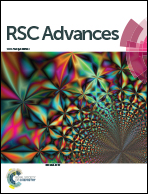Periodic silver nanodishes as sensitive and reproducible surface-enhanced Raman scattering substrates†
Abstract
Highly ordered silver nanodishes which consist of nanorings and a film were fabricated as surface-enhanced Raman scattering (SERS) substrates. Numerical simulation reveals the bottom film can dramatically enhance the local electromagnetic (EM) field in the ring cavity, due to the plasmonic interaction between the nanorings and the film. Raman results show that the nanodishes can produce about sevenfold stronger signal than the nanorings alone, in accordance with the theoretical simulation. The detection limit for Rhodamine 6G (R6G) in the order of 10−12 M and the average relative standard deviation (RSD) of less than 12% indicate the excellent sensitivity and reproducibility of silver nanodishes. The SERS enhancement factor (EF) of R6G on the nanodishes was calculated to be 6.17 × 107. For practical application, the silver nanodishes were also used to detect thiram, one dithiocarbamate fungicide that has been extensively used as a pesticide in agriculture. The detection limit of thiram molecules is as low as 1 × 10−7 M, which can meet the requirements for ultra trace detection of pesticide residues. The resulting substrate with high SERS activity, stability and reproducibility makes it a perfect choice for practical SERS detection applications.


 Please wait while we load your content...
Please wait while we load your content...